Barefoot vs Minimalist vs Traditional Running Shoes - Which Is Better For Your Feet?
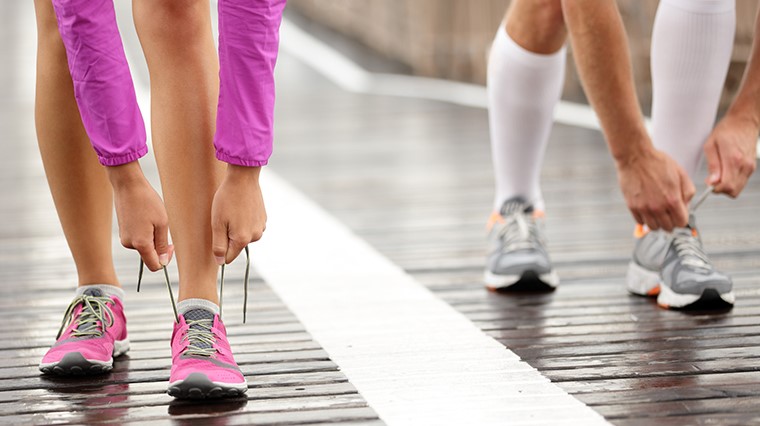
The
barefoot movement expresses that your feet didn’t evolve to wear shoes. Conventional
theory argues, you didn’t evolve to run on hard road surfaces either and
traditional running shoes compensate for that.
With
all honesty, you could spend hours untangling the contradicting studies on the
matter – with scientists, podiatrists and athletes all weighing in with
clashing opinions.
Instead,
we’re going to break down the basic features of barefoot, traditional and
minimalist running shoes and put them side by side to provide insight on which may be worth considering for you and the running experience you’re hoping to achieve.
We'll also visually compare the conventional Asics Gel Kayano 26 stability running shoes and
Vivobarefoot Primus Lite barefoot running shoes to highlight how common running shoe features vary between these categories.
Weight
Barefoot running shoes:
No
surprises here – barefoot running shoes are by far the lightest, usually weighing less than 200 grams. In their
nature, barefoot running shoes strip back non-essential cushioning and
stability characteristics to rely solely on your body’s natural shock absorbing
mechanisms.
They’re
designed to conform more naturally to the shape and structure of the foot, almost sock-like, and only provide ultra-thin protection of the outsole for
increased sensory feedback and reduced bulk. Overall, they create an
ultra-lightweight, barely-there barefoot experience and reduce energy wastage
as there’s less weight to carry.
Traditional / conventional running shoes:
High-end
conventional running shoe brands are constantly engineering new tech to create
a lighter ride through lightweight cushioning technologies like Asics FlyteFoam, Brooks DNA Loft, New Balance Fresh Foam or Adidas Boost as a few current examples. It’s simply a fact of
life that the same weightless feel of barefoot shoes can only
be achieved by compromising on cushioning and stability, at least for the most part.
Stability
running shoes that feature additional arch support for overpronation control
tend to weigh more with specialised technologies to guide the foot into a more
neutral motion path.
Minimalist running shoes:
In terms of weight, minimalist running shoes generally fall somewhere in the middle. They still offer a degree of cushioning, but not in excess. Their goal is to maintain a more natural running gait than a traditional running shoe allows, while offering more impact protection than a barefoot running shoe – and their weight is a reflection of that.
Heel Drop
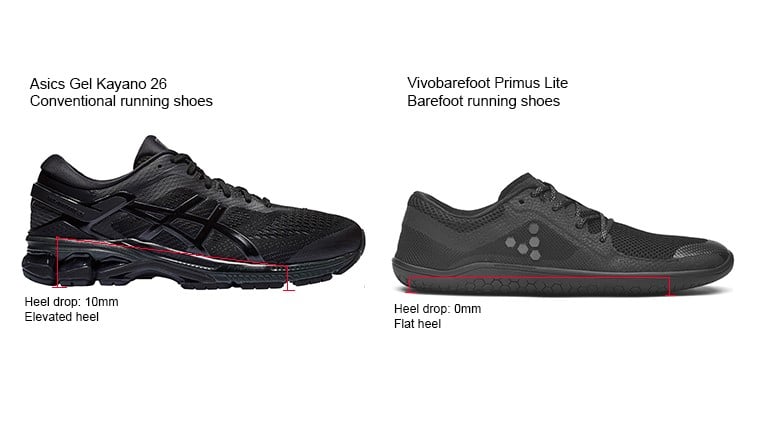
Traditional / conventional running shoes: 10-12mm drop.
Heel
drops can vary among models and brands, with Brooks running
shoes and Mizuno
running shoes generally sticking with the trusted 10-12mm heel drop,
excluding their more minimalist models. This elevation of the heel paired with a relatively high stack height (a measurement of how thick the shoe is beneath your foot) accommodates
cushioned midsole technologies to create a plush, dampened
feel for tackling repetitive impacts during high mileage running.
With more substance
in the heel, these running shoes often cater to and help disperse forces involved in high impact heel strikes. Also, they're a more suitable option for runners susceptible to Achilles tendonitis, as they target impact
stress away from the lower leg, to the upper knees and hips.
Barefoot running shoes: 0mm
Barefoot shoes like
Vivobarefoot running shoes have a heel-to-toe drop of 0mm, translating to an
entirely level platform between forefoot and heel, and coupled with an extremely thin stack height for a low-to-ground feel.
As there is no elevated
heel, the idea is barefoot shoes improve posture, balance and emphasise the forefoot and potentially midfoot strike.
In fact, heel
striking in barefoot shoes puts you at high risk of injury.
With a 0mm heel
drop, heel protection simply isn’t there. Heel striking in barefoot shoes hurts - encouraging you to adapt to running
with a more prominent forefoot or midfoot strike with some tough love. These are generally considered as the more natural running strides.
It's worth noting that when you are fatigued on a long run, your proper running form may suffer and tend towards a heel strike - which for safety's sake, isn't compatible with barefoot shoes. Although they may be
more biomechanically efficient, and this is up for debate, the fact that
barefoot shoes are free of cushioning technologies may cause your feet to
fatigue faster – so it’s a game of weighing up the pros and cons.
Minimalist running shoes: Less than 8mm drop
Saucony running
shoes offer a minimalist, low profile feel with 4-8mm heel drops. 4mm drops and lower
allow runners to break free from dependence on the stability and cushioning
characteristics of the running shoes, putting more focus on the tools you were born
with for natural motion.
With less physical heel getting in the way, heel strikers transitioning to minimalist running shoes may find they have a less pronounced heel strike, which may translate to improved running efficiency as striking the ground heel-first tends to act as a brake.
Outsole: Durability And Protection vs Flexibility And Sensory Feedback
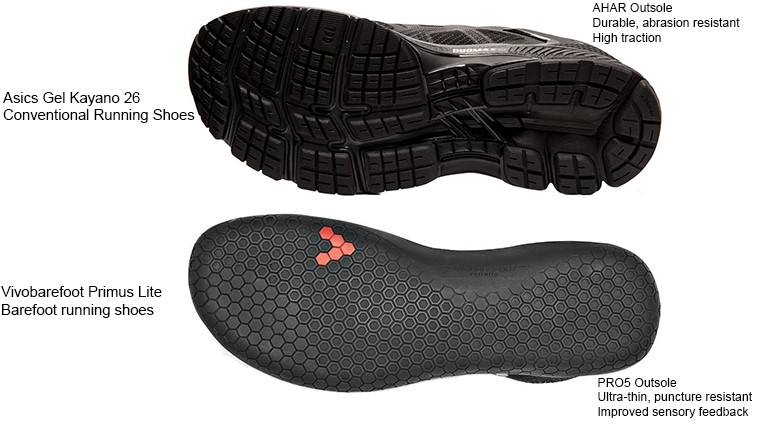
Traditional / conventional running shoes:
The purpose of the outsole is to provide durability, traction and a protective barrier between
your feet and hard or hazardous surfaces.
Traditional running shoe outsoles
contain grooves or channels to provide grip for forward-motion.
The forefoot area
tends to be particularly flexible to allow for snappy toe-off and a responsive
feel, while the heel tends to be thicker and more durable to withstand
repetitive impacts.
Conventional outsoles are often made with airy and flexible
blown rubber for a cushioned feel and/or heavier carbon rubber for increased
durability. If you hold a
traditional shoe with forefoot in one hand and heel in the other, and twist in
opposite directions, you’ll find there is considerable resistance from the
outsole, with this rigidity helping maintain structure.
Barefoot running shoes:
The outsole of barefoot
running shoes is ultra-flexible from heel-to-toe. Vivobarefoot running shoes
can be scrunched into a ball and quickly spring back into shape. Your feet can run and flex naturally and every muscle can be put to work
without restrictions.
They’re also
incredibly thin to literally allow you to feel more of the world beneath your
feet. Like your hands, your feet have sensitive nerve endings and barefoot
shoes allow you to use your body’s natural tools to improve sensory feedback
and proprioception - that is your awareness of your body in space.
Minimalist running shoes:
Thinner than a traditional outsole, but with more sturdy protection than an ultra-thin
barefoot outsole. Typically, they aim to be structurally light and feel fast
without overly compromising on durability.
When running shoe
brands get it right it can offer an ideal balance for road warriors seeking a
hybrid between a traditional and barefoot shoe, but it can be a hit and miss
depending on the model and manufacturer.
Strip back the
outsole too much, particular in high wear areas runs the risk of the shoe
wearing out prematurely and may neglect to provide enough protection of the midsole.
Midsole:
Cushioning
Traditional / conventional running shoes:
Conventional road
running shoe manufacturers take on the problem of repetitive impacts on hard
surfaces – tarmac, concrete and pavement – and engineer cushioning midsole
technologies to protect and reduce fatigue for road warriors to battle more
miles in comfort. As we move forward, these midsole technologies are
progressively becoming lighter to fit the needs of everyone from the weekend
jogger to the elite marathoner.
The goal is comfort
and reduced risk of overuse injuries without overly sacrificing responsiveness
– an ultra-spongy marshmallow feel underfoot is not the way to go when you want snappiness, for lack of a better word, to propel you into your next stride.
Not only do these
technologies compress on impact to absorb shock, but the more innovative foams
will bounce back into shape quickly and responsively like Asics FlyteFoam, or adapt to every stride,
your pace, bodyweight and running surface like Brooks BioMoGo DNA and DNA Loft
for smooth energy return.
Although all road
runners can benefit from a degree of protective cushioning, supinators with
high arched feet that roll outwards in particular, require highly cushioned
shoes. This foot type fails to provide adequate natural shock absorption with
the arch’s inability to ‘collapse’ and cushion on impact.
Barefoot running shoes:
Barefoot translates to
bare minimum when it comes to the midsole - arch support and cushioning
technologies don’t fit into the barefoot principle of allowing your feet to do
their thing naturally.
A highly cushioned
running shoe can feel like you’re wearing tiny pillows on your feet. Being free
of the dampening effects of cushioning in barefoot shoes allows for improved
sensory connection with the road or trail and heightened proprioception.
Barefoot shoes aim
to make you literally feel more by putting less interference between you and
your running surface.
Feeling every pebble beneath your feet provides
an additional level of stimulation for the brain – which will react to changed conditions
and relay messages to your feet to instinctively stabilise when the ground
underfoot becomes rocky or hazardous – in a similar way you’d flinch
unconsciously if you step on something sharp.
Going barefoot
allows your body’s natural defences to be put into play – but does run the risk
of pain or injury especially over long distances, hard surfaces and if you haven’t gradually transitioned to the barefoot
lifestyle. As we touched on earlier, this can be more of a challenge for
severely supinated (high arched) foot types – with inadequate cushioning
causing higher risk of stress fractures.
Minimalist running shoes:
Many minimalist
running shoes often provide a degree of cushioning - combining a fast, low
profile with a plush underfoot feel. For example, the Saucony Kinvara 9 running shoes couple
a light, minimal upper and outsole for speedwork and race day with
energy-returning EVERUN cushioning for shock protection.
Midsole: Stability And Support
Traditional / conventional running shoes:
Overpronation – that
is, the excessive inward rolling or rotation of the foot due to low or flat
arches – is common among many runners and may cause muscle stress to the inner
edge of the foot and prevent a neutral distribution of load through the sole. Pain,
if evident, may not only be isolated to the arches, but can affect your
Achilles tendons, ankles, heel, shins, knees and hips.
High-end running
shoe brands provide a solution in their stability running shoe categories with
more structured cushioning and firmer midsoles to support the arches and better
align your gait. The DuoMax Support system in a number of Asics high-performance models for overpronation control is a good example.
Running-specific
companies like Brooks focus on how running effects your body from foot, to
knee, to hip. They specialise in guiding
rather than correcting the movement of
your feet as you transition through the gait cycle, with neutral and
overpronation-friendly tech like GuideRails that only kick into action to
stabilise your motion when you need that touch of extra support, to prevent overly
interfering with your natural stride.
Barefoot running shoes:
According to the
barefoot movement, it’s less about the structural issues of whether you have
collapsed arches and flat feet that lack support, or high arches that offer
minimal natural cushioning, and more about how strong
your arches actually are.
Weaker arches
whether low, neutral or high, are potential causes for pain and discomfort – as
the tiny bones, ligaments and tendons in your foot can not as readily provide
support. Being free of arch support and orthotics, barefoot running shoes force the
muscles in your feet to do the work – and like any muscle, they become stronger as a
consequence of being activated.
With your muscles
doing the heavy lifting, your body learns to adapt, and your feet will
strengthen - which may mean less injury risk in the long run, but again, this
is debatable and every foot is different.
Minimalist running shoes:
Minimalist shoes cut back on arch support and prioritise a light and natural ride with minimal interference to your unique stride. However, they don’t necessarily neglect stability features altogether and may offer moderate degrees of overpronation control.
Upper: Toe Box
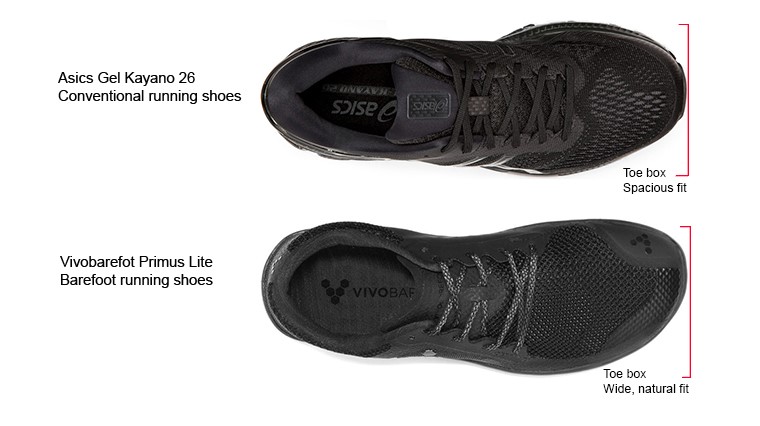
Traditional / conventional running shoes:
Conventional running shoe toe boxes vary significantly across brands and models – from shallower to more wider widths, and generally don’t conform as naturally to the foot shape as barefoot shoes. However, many models from high-end running brands factor in the necessity for toe boxes to be spacious enough to accommodate the natural swelling and lengthening of the forefoot – particularly in the case of high mileage running.
In the case of traditional shoes, seeing as they have a more structured, stiffer feel than barefoot styles, a deeper toe box can run the risk of feeling a touch ‘boxy’ like a coffin for your feet, so be aware of that and potentially seek a shoe with narrower width offerings if this is more fitting with your foot type.
Barefoot running shoes:
Barefoot toe boxes are wider to accommodate the natural splaying of the toes on impact for a more even distribution of stress and dispersal of shock.
Look at your feet. The widest part of your foot is anywhere from where your toes meet the rest of your foot to the tips of your toes – so shoes that taper aggressively inwards at the forefoot simply aren’t designed for natural movement as they squash or constrict the toes. That’s exactly what barefoot shoes combat – providing plenty of toe wiggle room and allowing natural foot function of the entire foot.
Some ultra-barefoot shoes go the next level to achieve a glove-like, anatomic fit to better resemble a truly barefoot experience. They feature individual compartments for each toe to allow the smallest muscles in your feet to activate, adapt and grip onto changing terrain and move more independently of your other toes – acting like a second-skin.
Minimalist running shoes:
Minimalist shoes tend to fit in the middle – not quite as prominently ‘duck-feet’ shaped as barefoot shoes as they widen out in the forefoot, but with a touch more wiggle room than many traditional styles.
Toe Spring
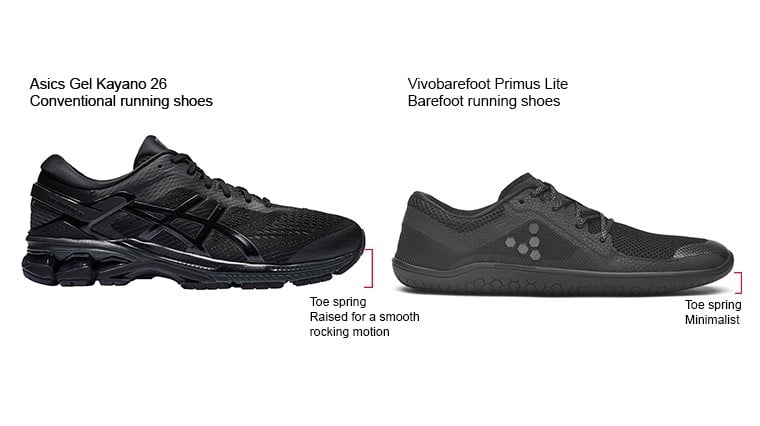
Traditional / conventional running shoes:
Place your
conventional running shoes on a flat surface and you’ll notice the toe box is slightly raised above the
ground.
This feature - called a ‘toe spring’ - is common to traditional running
shoes, helping to support the forward rolling motion of the foot as you
transition through the gait cycle. Coupled with a forefoot flexibility of the
outsole, this allows the shoe to compress at the toe during your runs for
smooth propulsion at toe-off.
This also helps prevent the shoe from feeling
overly rigid or restrictive to compensate for a stiffer construction.
Barefoot running shoes:
In staying true to the
barefoot philosophy, barefoot shoes may skip the toe spring altogether in
preference of a pancake-flat platform or very minimalist toe spring that better represents the anatomy of the
foot. This is intended to allow the toes to engage more naturally with the
ground during the gait cycle – allowing your feet to do the work without
interference.
Minimalist running shoes:
The upward curve of
the toe spring in minimalist shoes is usually less prominent than their
traditional shoe counterparts. Paired with the flexibility of the shoe,
they flatten out smoothly on impact.
Considering transitioning to the barefoot lifestyle? Ask your podiatrist to do a foot analysis to identify whether barefoot running is a safe option for you.
